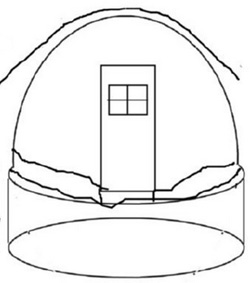
Email from a reader: Hello, I am trying to put together a design for an earthbag dome built into a hill in New York, and for a few reasons, I would like to have some of it underground. Actually, there are two adjacent domes, one with a diameter and height of 14′, and the other 8′. The frost line here is at least 48″, and I’ll probably go down further.
I was looking to the design on Jovoto.com for inspiration. Does encasing the entire bottom of the dome in a waterproof membrane mean no foundation is necessary? Is there a better alternative? I worry about moisture leaking in through the seams of the polyethylene, but if I bind them (using an iron?), or alternate where they overlap, can I avoid this problem?
Slightly off-topic, but there’s a lot of slate on my property, and I’m wondering if it would be too much weight to cover the exposed part of the dome with it?
Thank you so much for your input, Georgie
Owen: This design is most suitable for small, low value structures such as vacation cabins, temporary shelter, etc. and if that’s what you’re planning then yes it can work. Just realize that domes evolved in deserts, and they are vulnerable to water damage in temperate climates. Building below grade increases the risk of water damage. A better option is to build above grade with earth berming.
I would fill the lower courses with gravel or preferably some type of insulating fill such as porous volcanic rock (scoria). The gravel bags act as a foundation. Plastic sheeting punctures very easily and most likely one layer will leak. I recommend heavier duty bituthene rubber. Shop around and you can find lower cost brands.
Adding slate on top is not a problem because domes are extremely strong. The main concern again is protecting against water penetration. Just imagine all that melting snow in NY.
A longer lasting option is to build small roundhouses with roofs made of wood poles and bales covered with bituthene and sod.

I thought this page from earthbagbuilding.com explained a similar design well: http://earthbagbuilding.com/projects/mendome.htm
Hey guys. I drew this plan up several years ago in response to a contest to design inexpensive housing options. The main reason the dome wasn’t corbelled looking was because of my sloopy photoshop drawing! LOL! I have never built a dome and probably won’t–I like putting roofs on my EB buildings and know that domes can be demanding. I usually talk people out of building domes these days because of possible moisture options like Owen mentioned and the structural challenges they present. The plastic could work, you would want the overlap above grade–the top plastic would overlap the lower, allowing water to run off. Now I’m designing something I call “The Ark,” which is a mostly below ground earthbag roundhouse with a large earthbag water cistern attached, especially designed for desert living.
I’d love to hear more about your Ark design.
Have you seen my free desert shelters? http://5892-presscdn-26-36.pagely.netdna-cdn.com/wp-content/uploads/2012/05/Desert-Shelters-PDF.pdf
Thanks for sharing, Owen–some nice ideas in there! I want to draw up the ark and put it online for free as well. If things keep going as they are, mostly underground survival shelters may become more appealing in the coming years.
My daughter is building a series of earth bag domes here in the Ozarks. We have looked at several ways to water proof and the latest we stumbled upon is the poor man’s fiberglass. It is using material (like canvas or bed sheets) and painting them on the outside of the dome with titebond II glue, then painting an extra exterior latex coat over that. Have any of you tried this?
Building below grade in an area with high rainfall and high water table is almost doomed for problems. Water flows downhill of course. It would be much better to build above grade on high ground and add earthsheltering with living roof on top like my dome: http://www.instructables.com/id/How-to-Build-an-Earthbag-Dome/
From Kelly Hart:
Hi Georgie,
I think that that design was concocted by someone without much real experience building earthbag domes. It is much too rounded on top to be safely self-supporting. If you look at the space available above the door there is no room for a loft. And, practically, you can’t put a flat door in a rounded wall with that sized dome without either buttressing it inward or extending an entryway outward. Further, the concept of gluing or ironing sheets of plastic together to form a watertight seal will not work over time; at some point it will begin to leak, and then you have problems.